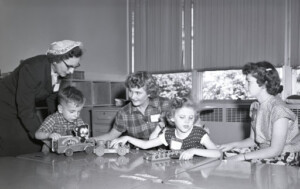Oregon State School for the Blind
Established by an Act of the Legislature in 1872, the Institute for the Blind had almost as transitory a history as the school for the deaf, occupying three sites in its long existence.

McEwan’s Photo Shops Salem, 1955–06-04, 3 unknown women sitting w/same boy & girl at table w/toys McEwan Photo Shop No. 885. State of Oregon Blind School. Lion Club committee sitting with pre-school children, WHC Collections 2006.002.0885.002
The school opened the February 26, 1873 in the William Nesbitt home and was taught by Miss Nellie Simpson who was herself blind. Two students were present at the school’s opening, but before the end of the term, five students had been enrolled. Then in April of 1874, a disaster occurred that interrupted the school year and caused its closure. Mrs. Nesbitt had been thrown from a wagon, with fatal consequences. No one could be found to take her place as matron. In July Miss Simpson left the state. By October of that year, a new superintendent had been appointed and the school resumed, its location at 13th Street between Court and Chemeketa. Within five years it again had closed. Reopened in 1883 with C. E. Moore as superintendent, the institute found a new home on 12th Street between Ferry and State. This building later became the home of Salem’s first hospital.
When the Deaf-Mute School moved to East Salem in1894, the Blind School took over their property on the east side of Church and Mission Streets. Their mission–to provide a residential facility for the state’s blind people to receive training in self-help skills, language development, and work skills–remained the same. Physical education was also emphasized as “in many cases the cause which produced blindness brought also a weakening of the entire constitution.” Music and debating societies were featured activities, and, just as with the other Salem institutions, a small garden and orchard was attached to the facility to provide food for the table and employment for the older students. A library stocked with books in Braille had, almost from the school’s first inception provided reading opportunities for the boys and girls, men and women.
In 1909 industrial work was added to the curriculum: basketry, weaving, chair caning, hammock- making and piano tuning. For the thirty-plus years the school had been in existence, the need for training blind adults as well as educating the younger ones had become apparent. Often the student body was composed entirely of adults. This need led, four years later, to the establishment in Portland of the Oregon Blind Trades School, where training in broom making, chair caning, rug and carpet weaving, bead and fancy work were offered in a residential setting.
That same year, in Governor West’s Biennial 1913 message, he recommended closing the blind school as it had become a fire trap; besides which, the school was “so located that a railroad track, a mill race and a creek, which at times is a raging torrent, must be crossed by the blind children in going to or from the school or city.”
The Governor’s concerns were apparently ignored. Fortunately, no tragic conflagration occurred for a new fireproof cottage wasn’t built there until 1923 as a boys’ dormitory. Not until the 1950’s was the old school building torn down and a new brick edifice put in its place.
The school operates today on the same eight and one half acres Asahel Bush donated to the state in perpetuity, so long as it was used to provide educational opportunities for the handicapped.
Bibliography:
Daily Oregon Statesman. February 13, 1873, p. 3; July 16, 1873, p. 3; January 7, 1894, p. 2.
Oregon Statesman. Illustrated Annual, January 1, 1900, p.8.
Biennial Report of the General Superintendent of the Oregon Institute for the Blind. Sept. 1874-Sept. 1876.
Satchwell, Wayne & Mildred S. Gibbens, Status of the Blind in Oregon, Oregon Council for the Blind, 1977.
Governor Oswald West’s Biennial Message. 1913.
Conversation with Mildred Gibbens, former music teacher at the Blind School. Dec. 7, 2000.
This article originally appeared on the original Salem Online History site and has not been updated since 2006.







Leave A Comment